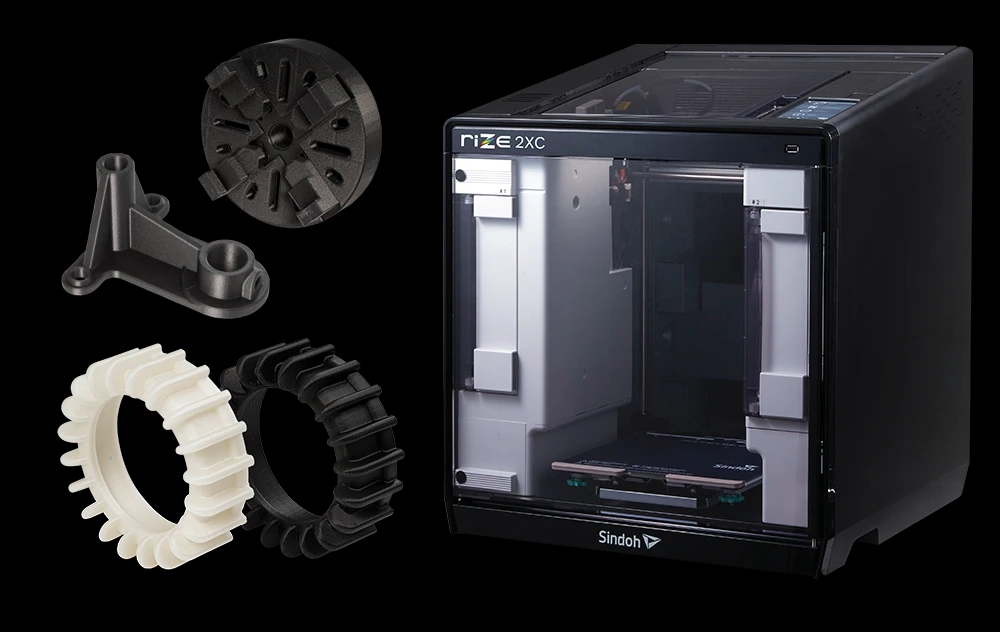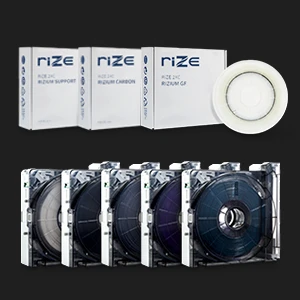
What really makes a difference for safety in 3D printing is the materials science, says the CEO of RIZE.
In part one of our recent conversation, Andy Kalambi shared insights into the RIZE perspective on safety and a look ahead to 2021. We reconnected to expand on that, though, as he wanted to clarify something important:
“The 2XC announcement not about a printer, not even about GREENGUARD. That’s not the story, in my opinion. The real story is that materials science makes a difference.”
3D Printing Materials Science
That simple statement is something we need to think more about: materials science makes a difference.
When it comes to 3D printing, there’s a requisite trinity for success:
- Hardware
- Software
- Materials
We could argue that the first wave of 3D printing, when the technology suite was initially being developed in the 1980s, hinged primarily on hardware. More recently, software and materials have been more in focus. Without targeted, powerful software, even the most finely-tuned hardware can’t live up to its potential. A 3D printer is only as smart as its software tells it to be, essentially.
Materials, though, are another story. Much of the focus to date, when it comes to more powerful, professional 3D printing, has been in introducing materials familiar from traditional manufacturing. That is, engineering-grade materials like PEEK and PEKK, or more metals like copper and more aluminum alloys.
But that’s not all materials science is, of course, figuring out how to make known materials adapt to being 3D printed. It’s also in developing wholly new materials with qualities that make them tick more boxes in actual production: functionality, look, feel, and — perhaps the least-frequently touted or least understood — safety.
Increasing studies have shown that 3D printing can release volatile organic compounds (VOCs). Reducing these emissions is a key part of 3D printing safety. Many companies do this for their printers through incorporating HEPA filters, enclosures, and other ways of containing or filtering particles emissions.
But RIZE tackles the issue differently: by not having emissions.
RIZE Materials Focus

This isn’t to say that RIZE is the only company in the 3D printing industry paying significant attention to materials science and the tie to safety — not by any stretch. But the company is among those leading the way in laying groundwork that should be seen as a path ahead for the industry as a whole.
“In the 3D printing industry, it’s been appreciated, but I don’t think it’s been fully leveraged,” Kalambi said of materials science focus. “I say that because what we’ve done with RIZIUM is to engineer the material to a purpose. We didn’t take a material which was already there and try to fit the purpose to the material, which has been the traditional way of manufacturing. Often you’ll start with tool steel and say, ‘What can I do with tool steel?’ It’s the same with ABS or nylon: ‘I’ll fit my purpose to nylon.’ What we did with RIZIUM was fit to the purpose of emissions, with durability, no moisture absorption, with strength through composites. We engineered the material to the purpose, then introduced it to the printer.”
The trinity here for RIZE’s materials development is:
- Strength
- Durability
- Safety (re emissions)
These specific focuses fit into the two overarching messages Kalambi is driving forward for the company, which he lays out as:
- Safe, affordable color
- 3D printing in color at the same price users 3D print normal FFF parts
- Safe anywhere manufacturing
- “We want our printers and other printers to be safe to use anywhere”
The color focus is an important one, as Kalambi noted that “most 3D printed materials don’t handle color that well.” RIZIUM interacts with color quite thoroughly: “it’s a dye which reacts and changes the material properties inside.”
“We have a voxel-level technology, impregnating the polymer with the ink. This changes the material property to see color, and it’s a new material, a better material,” he said.
The color is inside the print, essentially; it’s not a surface-level paint job. This ensures that the color stays true and will not easily fade, will not chip away from handling.
“Behind all this is materials science,” Kalambi underscored, especially for the development of the 2XC 3D printer, which was developed with Sindoh based on that company’s existing desktop FFF design. “Let’s take an [FFF] printer that’s been on the market and put this all to the test. Can this material deliver on this purpose we have, which was safety, durability, and strength? We were working with baited breath. Our previous printer had been designed with all that in mind. This printer, we had to do some engineering. But we didn’t do anything that couldn’t be done on another printer. This is the test, something that could withstand the very stringent UL GREENGUARD requirements.”
And, as we know, the RIZE 2XC has been GREENGUARD certified. Per Kalambi’s noting that this 3D printer was developed from technology already on the market, it’s easy to make the leap to his point: safety certification is possible for 3D printers on the market.
“The RIZIUM Alliance shows that, with materials science, we can solve a problem this industry has been facing for the last 30 years. That is, why these printers are not safe in a consumer setting where people are sitting closer to them,” he said.
Materials Science For 3D Printing Safety
Kalambi’s big hope is that RIZE doesn’t long remain the only company offering GREENGUARD-certified 3D printing products. It’s nice to be able to tout such a claim, but it’s nicer still to be the one kicking off a flurry of those claims. UL-certified 3D printers and materials can hopefully become more of a focus in this industry, and then more of a norm.
“How fast can I print it, what size can I print it; those topics are uppermost in people’s minds. Then materials, in wanting to replace or augment what you’re doing in subtractive with additive manufacturing,” Kalambi said. “The long-term opportunity is to replace it with better materials science.”
Currently available 3D printing materials all have some constraints, from toxic emissions to moisture absorption. Then there are considerations of color capabilities.
“All those things are driven by materials science,” Kalambi continued. “I want to bring attention to the topic.”
RIZE is wholeheartedly “a company that is led by materials science,” as its CEO likes to say. Focusing on what materials science can offer in terms of safety and quality is the next step forward for better-performing, human-safe industrial additive manufacturing. That the 2XC 3D printer, based on an existing FFF design, could live up to the stringent guidelines laid out in UL GREENGUARD certifications is a major testament to this idea.
“3D printing is a synthesis of mechanical engineering technologies — lasers, heat, sintering — with materials science. When you bring the two together, that is the full power of additive manufacturing. That was my learning in the last years in 3D printing. You need to pay as much attention, if not more, to materials science as you do to the core 3D printing technology. That’s where we’re going,” Kalambi said.
Via RIZE
